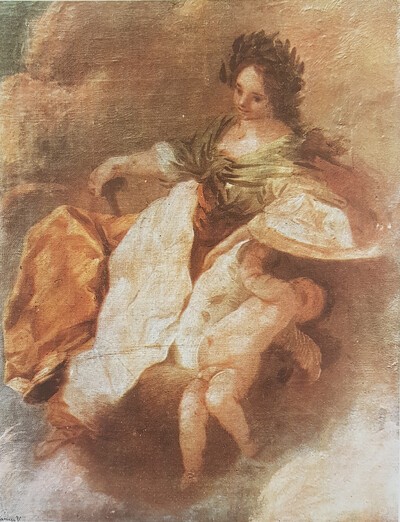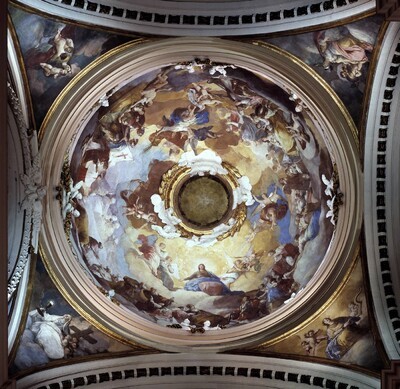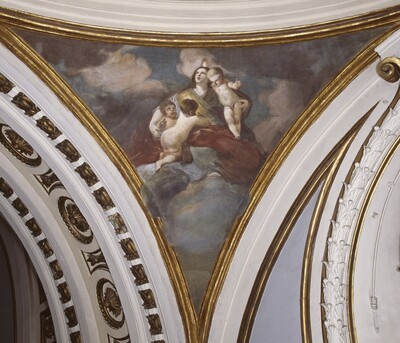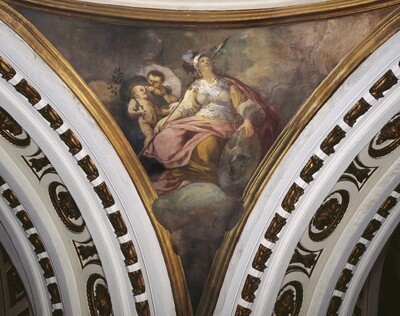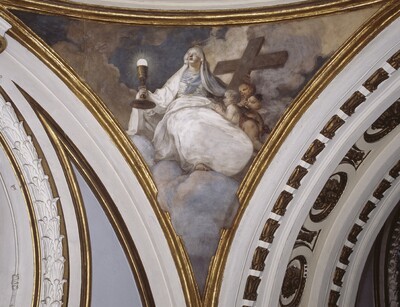- Cronología
- 1780
- Ubicación
- Basilica of Our Lady of the Pillar, Zaragoza, Spain
- Dimensiones
- 83.59 x 167.18 cm
- Técnica y soporte
- Oil on canvas
- Reconocimiento de la autoría de Goya
- Documented work
- Titular
- Metropolitan Chapter of Zaragoza
- Ficha: realización/revisión
- 10 Oct 2010 / 13 Jun 2023
This sketch was presented along with the sketch corresponding with the other half of the cupola to the Building Committee of the Metropolitan Chapter of Zaragoza on 5 October 1780. See record Regina Martyrum.
Both were acquired by the Metropolitan Chapter of Zaragoza in 1805, together with another 12 sketches for various vaults and cupolas painted by the Bayeu brothers for in the Basilica. They were purchased for a sum of 660 libras jaquesas, 17 sueldos and 8 dineros in Madrid at the estate sale of Ángela Sulpice, the widow of Leonardo Chopinot who had acquired them some years before.
This is a sketch in the shape of a round arch inserted in a rectangular canvas that represents the main section of the cupola, which shows the Virgin as Queen of Martyrs accompanied by a part of the heavenly court. In general, there are few differences between this sketch and the definitive painting, excepting some variations in the poses, hairstyles, iconographic attributes and colour palette used for the figures' clothing.
It is a very lively piece, thanks to a technique derived from the work of Giaquinto that relies on quick, impasto brushstrokes and deft highlights.
-
Exposición de bocetos para pinturas y esculturas (Siglos XVI-XIX)Sociedad Española de Amigos del ArteMadrid1949cat. 137
-
cat. 15
-
El arte europeo en la corte de España durante el siglo XVIIIGalerie des Beaux-ArtsBurdeos1979Exhibitied also at Grand Palais, París y Museo Nacional del Prado, Madridcat.14/2
-
GoyaLa Lonja, Torreón Fortea y Museo Pablo GargalloZaragoza1992consultant editor Julián Gállegocat. 8
-
Realidad e imagen. Goya 1746 – 1828Museo de ZaragozaZaragoza1996consultant editor Federico Torralba Soriano. From October 3th to December 1st 1996cat. 16
-
Zaragoza2021
-
Vie et ouvre de Francisco de GoyaParísOffice du livre1970p. 92, cat. 178
-
BarcelonaPolígrafa1970vol. I, p. 253, cat. 117
-
Regina Martirum GoyaZaragozaBanco Zaragozano1982p. 36
-
Los bocetos y las pinturas murales del Pilarcol. col. Mariano de Pano y RuataZaragozaCaja de Ahorros de la Inmaculada de Aragón1987pp. 52, 131-144
-
Goya y Aragón. Familia, amistades y encargos artísticoscol. Col. Mariano de Pano y RuataZaragozaCaja de Ahorros de la Inmaculada de Aragón1995pp. 127-141
-
Las pinturas murales de Goya en AragónMadridGobierno de Aragón y Electa España1996pp. 49-73
-
Realidad e imagen. Goya 1746 – 1828MadridGobierno de Aragón y Electa España1996cat. 16
-
La cúpula Regina martyrum de la Basílica del Pilarcol. Colección Monumentos RestauradosMadridFundación Caja Madrid2008pp. 108-109
-
Goya. Traveler and artist of the Grand Tour (exp. cat.)ZaragozaGobierno de Aragón2021p. 208

